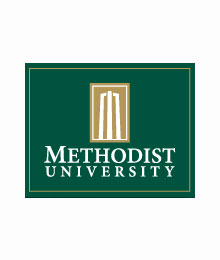
Methodist University Golf Club
Kyle Fera, Recruiter
5400 Ramsey St.
Fayetteville, NC 28311
http://www.methodist.edu/academics/programs/pgm
kfera@methodist.edu
Facility Amenities:
- Grass tees (4)
- Bays with Mats (4)
- Accurate yardage measurements on tees to targets
- Short Game Practice Area
- Grass Putting Green
- Covered Areas
- Golf shop (600 sq. ft.)
- Heated Bays (4)
- Indoor Simulator
- Ball Flight Monitor
- Club repair lab
- fitting carts
- various technology including Trackman and video cameras
Type of Range Targets:
- Flags
- Bunkers
- Built-up greens
- Fairway cuts
- Wedge range made up of 17 sand circles that are 4ft. diameter each with yardages starting at 20 yards and increasing in 10 yard intervals up to 100 yards (for example, 20, 30, 40, 50, 60, 70, 80, 90, 100 yards). We have six greens mowed at short height that are outlined and defined with bermuda rough around the edges for clear visual definition. Each green has 1-2 poles with flags on top. Two fairway bunkers positioned 30-35 yards apart to simulate the width of a fairway. We have 10 very large poles (schedule 80 pvc) that are painted different colors based on distance from the middle of the range tee (red = 100 yards, black and white striped = 150 yards, blue = 200 yards, and yellow = 250 yards. We have three poles at 100 yards (red) that are separated by about 16 feet each. We used 16 feet because in 2015 be best player on the PGA Tour averaged 15 feet 6 inches for their average proximity to hole for the year from 100-125 yards (Tom Hoge). We used the same concept when determining how far apart to place the 150 and 200 yard poles. The heights of these poles range from 8 feet to 14 feet so they are clearly visible from all of the hitting spots on the range tee. We have two Sonix targets with our MU logos. We have two “tee targets” which are portable circle nets with yellow accent tubes that are used for pitch and wedge shots. The distance and locations of the Sonix targets and “tee targets” vary every day. For certain special events and clinics we use additional visuals like hula hoops, alignment sticks with pool noodles, and orange roll flagging or surveyor tape. Hula hoops are used for landing targets. Alignment sticks with pool noodles are used for start direction and curve. Roll flagging or surveyor tape is used for games like tic-tac-toe and to highlight certain distances for proximity to hole.
Instruction provided.
Number of PGA Professional Instructors: 7
Clubfitting services provided.
Number of range balls dispensed per year: 5,000,000
Number of range balls in inventory: 25,000
New balls are acquired: Annually
Best range promotion: The best golf range promotion we ran this last year was the Player Development program. This Player Development program was available for all members to participate in and it was a requirement for all members that have not passed the PGA Playing Ability Test (PAT). These group classes met one time per week for twelve weeks in the Fall and for twelve weeks in the Spring. The classes were available at 9 different times during the week with each class lasting 50 minutes. For example, on Tuesdays the classes were offered at 1, 2, 3, and 4pm, on Wednesdays at 3pm, and on Thursdays at 1, 2, 3, and 4pm. The average class size in the Fall was 7p per class and in the Spring was 4p per class with one PGA Professional leading each class. The smaller class sizes in the Spring were due to the fact that as students passed the PAT they were no longer required to attend class. The first class of each semester was an introductory session where we covered the calendar of the next 11 weeks and taught the students about the differences between block practice and random practice along with best practices for transfer and mental game for tournament play. The next two weeks of classes I had the participants complete skills testing on ball striking and short game. We used tests from the former Linxtracker Performance Analysis Record (PAR) Test and we used tests from Charlie King and Rob Akins book “Golf’s Red Zone Challenge.” These tests served as a benchmark or starting point and measured the proficiency of each student in putting, chipping, pitching, bunker play, irons, and drivers. The tests all involved random practice instead of block practice and the testing phase took two weeks or two classes per participant. After the tests were complete we ranked all of the participants in each category and posted the results in the kiosk by the Player Center clubhouse so students could see where they rank in each area. We spent the next 7 classes working on each skill; for example one class covered putting and the next class focused on driving, etc. In each of these classes I gave the group a demonstration and then worked with each student individually as they completed an assignment each day. Each assignment involved a random practice drill or game where they had to keep score. For example, for putting we setup a 9-hole mini putting course on the putting green with every hole being a par 2. I also used some of the games in Trent Wearner’s “Golf Scrimmages.” The results of each drill or game were recorded, ranked, and posted in the kiosk again so participants could see where they ranked. The last two classes of each semester were used as a post test to re test the participants on the same test from the first two weeks in order to see how their games progressed from the start of the semester. In addition to the group classes the students were encouraged to take individual private instruction and they also had to complete a TrackMan Combine Test, turn in ten (10) scorecards from rounds played, and complete a SAM PuttLab putting measurement. The goal of this Player Development program was to help students prepare for the PGA PAT and to help them prepare for careers working in the golf industry.
Special Programs: Within the past year we have offered the following for our local community: Board of Visitors golf tournament, Salute Military Golf Association clinics, PGM Showcase day, and summer junior golf camps. For the Board of Visitors golf tournament we had our students/members caddie for participants. They played a shamble format with one MU student playing on each team and the participants were made up of local successful business people that are big supporters of our school. This was a special event because we are a walking only facility and this is the only event of the year that nonmembers can play our golf course. We hosted Salute Military Golf Association (SMGA) clinics in the fall and spring. Participants committed to a clinic series of 8 weeks where we did instruction every Monday from 10:00am-12:00pm and our PGA Professional staff had lunch with them from 12:00pm-1:00pm after each class to help build relationships with each participant. https://smga.org/ At the end of each series we took the participants out on the golf course for a 9-hole scramble to learn about on course etiquette, rules, strategy, etc. Participants that qualified were also fitted and given a new set of golf clubs. The PGM Showcase day was the only day of the year that other Methodist University students on campus that are not members were allowed to come down and experience our practice facility on campus. We played music over the speakers and setup fun games like “chipping pong,” long putt competition, putting course, long drive competition (TrackMan), corn hole, and can jam. At the end of the day we had a cookout, raised $ for local charities (Cystic Fibrosis Foundation, Pencils for Promise, and Operation Engage), and then we setup a big movie screen on the range tee and watched the movie Miracle. In the summer we hosted three different junior golf camps. One camp is a day camp from 8:30am-11:30am and is for ages approximately 6 to 16, which is open to anyone in the community. Another camp is the Methodist University PGA Golf Management College Summer Experience Camp that is for high school students interested in attending a PGA Golf Management program and this is an overnight camp where students stay on campus and eat meals in our cafeteria. The final camp was the MU Advanced Camp and was for recent high school graduates that were already committed to coming here to Methodist University. This was also an overnight camp and is a great preparatory or introduction for them into college.







